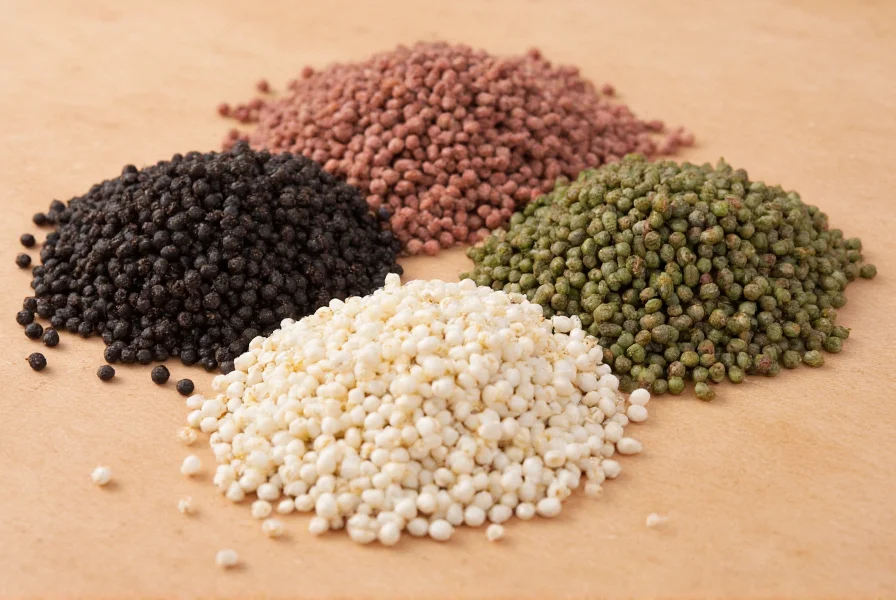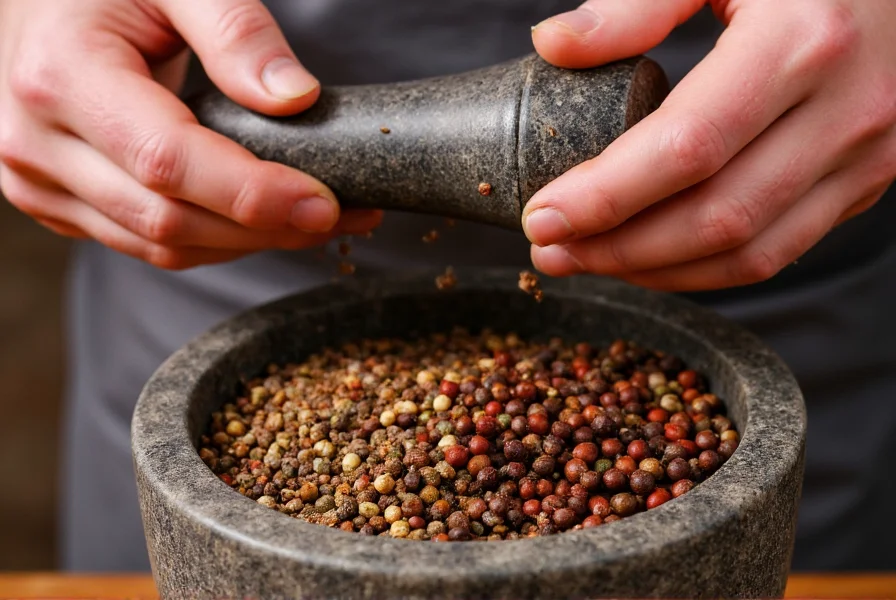When exploring the world of spices, few ingredients offer the versatility and historical significance of peppercorns. These small but mighty flavor enhancers have shaped culinary traditions across continents for thousands of years. Unlike pre-ground pepper, whole peppercorns preserve their essential oils and complex flavor compounds until freshly cracked, making them indispensable in serious kitchens.
The Botanical Background of Peppercorns
Peppercorns originate from the Piper nigrum plant, a flowering vine native to South India's Malabar Coast. This perennial vine produces small berries that transform into different peppercorn varieties based on harvest timing and processing methods. The transformation from berry to spice involves precise agricultural practices that have remained largely unchanged since ancient trade routes connected Asia with Europe.

Comparing the Four Main Peppercorn Varieties
Understanding the differences between peppercorn types elevates your cooking precision. Each variety undergoes specific processing that dramatically alters its chemical composition and resulting flavor profile.
| Type | Processing Method | Flavor Profile | Best Culinary Uses |
|---|---|---|---|
| Black Peppercorns | Unripe berries sun-dried until wrinkled and black | Pungent, complex with piney, floral notes and moderate heat | Steak seasoning, hearty stews, roasted vegetables, sauces |
| White Peppercorns | Ripe berries soaked to remove outer layer, revealing pale seed | Sharper, cleaner heat with earthy, musty undertones | Cream sauces, light-colored dishes, Chinese cuisine, pickling |
| Green Peppercorns | Unripe berries preserved in brine or freeze-dried | Fresh, herbal, slightly fruity with mild heat | French sauces, seafood, salads, Thai and Vietnamese dishes |
| Pink Peppercorns | Berries from unrelated Brazilian pepper tree | Floral, sweet, resinous with subtle heat and citrus notes | Desserts, fruit salads, finishing touch on grilled meats |
Maximizing Flavor: Storage and Preparation Techniques
Proper storage maintains peppercorn quality for up to one year. Keep them in an airtight container away from light, heat, and moisture—never above the stove where temperature fluctuations degrade volatile compounds. Whole peppercorns retain their essential oils significantly longer than pre-ground pepper, which loses 50% of its aromatic compounds within 15 minutes of grinding.
For optimal flavor release, use a burr-style peppermill rather than blade grinders that generate heat. Adjust the grind setting based on application: coarse for steak crusts, medium for general cooking, and fine for spice rubs. When recipes specify "freshly cracked pepper," they're referencing the volatile compounds that dissipate rapidly after grinding.
Culinary Applications and Pairing Principles
Professional chefs select peppercorn varieties based on dish composition. Black peppercorns complement rich, fatty foods like steak and duck where their complex heat cuts through richness. White pepper's cleaner profile works in béchamel sauces and mashed potatoes without visible specks. Green peppercorns shine in delicate preparations like poivre vert sauce for fish, while pink peppercorns add surprising dimension to chocolate desserts and berry compotes.
Consider these pairing principles when working with different peppercorns:
- Match peppercorn intensity to dish weight—light dishes need milder green or pink, robust dishes handle black
- Consider color impact—white pepper maintains visual purity in light sauces
- Balance heat with other elements—acidic components like citrus can amplify perceived spiciness
- Apply pepper at different cooking stages—early for infused flavor, late for pronounced heat
Common Misconceptions and Practical Substitutions
Many home cooks mistakenly believe all peppercorns come from the same source processed differently. While black, white, and green peppercorns derive from Piper nigrum, pink peppercorns actually come from the unrelated Schinus molle tree. This distinction matters for those with tree nut allergies, as pink peppercorns can trigger reactions in sensitive individuals.
When substitutions become necessary:
- Replace white pepper with a 3:1 mix of black pepper and allspice for similar heat without color
- Use capers preserved in vinegar as a green peppercorn alternative in sauces
- For pink peppercorn flavor, try a blend of black pepper and a pinch of crushed juniper berries
Understanding these peppercorn varieties transforms them from simple seasonings into precision culinary tools. The right choice enhances specific dishes without overwhelming other ingredients—a hallmark of sophisticated cooking technique. By recognizing each type's unique properties, you gain greater control over flavor development in your kitchen.

Frequently Asked Questions
What's the difference between black and white peppercorns?
Black peppercorns are unripe berries dried with their outer layer intact, creating complex, piney flavors. White peppercorns come from ripe berries with the outer layer removed through soaking, resulting in sharper, cleaner heat with earthy notes. The processing difference affects both flavor chemistry and visual impact in dishes.
Can I substitute green peppercorns for black in recipes?
Yes, but with adjustments. Green peppercorns offer milder, fresher flavor compared to black's robust heat. Use 1.5 times the amount of green peppercorns when substituting for black, and add them later in cooking to preserve their delicate herbal notes. They work particularly well in seafood dishes where black pepper might overpower.
Why do professional kitchens prefer whole peppercorns over pre-ground?
Whole peppercorns preserve volatile aromatic compounds that degrade rapidly after grinding. Studies show pre-ground pepper loses 50% of its essential oils within 15 minutes of grinding. Professional chefs maintain flavor integrity by grinding peppercorns immediately before use, ensuring optimal piperine content and complex flavor development in dishes.
Are pink peppercorns safe for people with nut allergies?
Pink peppercorns come from the Brazilian pepper tree (Schinus molle), which belongs to the cashew family. While not true nuts, they can trigger reactions in individuals with tree nut allergies due to cross-reactivity. Those with severe allergies should avoid pink peppercorns and consider substitutes like a blend of black pepper and juniper berries for similar floral notes.
How should I store peppercorns to maintain freshness?
Store peppercorns in an airtight container away from light, heat, and moisture. A dark cupboard works better than countertop storage, especially not above the stove. Whole peppercorns retain quality for 1-2 years when properly stored, while pre-ground pepper loses significant flavor within months. Avoid refrigeration, which introduces moisture that degrades quality.










 浙公网安备
33010002000092号
浙公网安备
33010002000092号 浙B2-20120091-4
浙B2-20120091-4